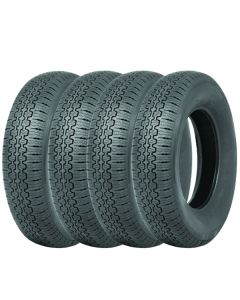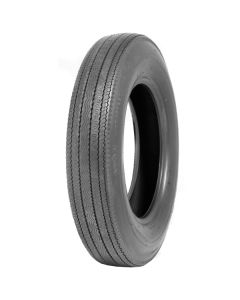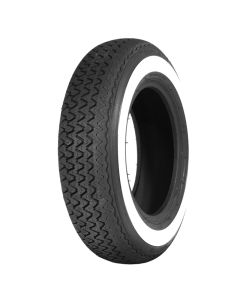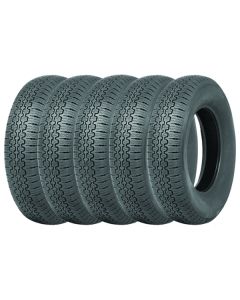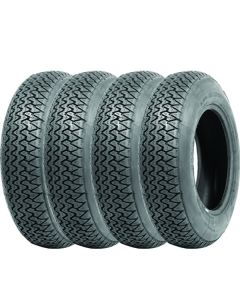Jaguar MKI & MKII Tyres

Silver Jaguar MKII on Borrani Wheels and 180 HR 15 Michelin XAS Tires
Jaguar MK1 & MK2 1955–1967
- When it came out in 1955 the MK1 2.4 Litre and 3.4 Litre Jaguar Saloon originally fitted 640 - 15 Crossply tyres.
- In the 1950s radial tyres were available with the Michelin X or PIRELLI CINTURATO ™ CA67.
- Today Pirelli still make the 185 VR 15 PIRELLI CINTURATO CA67, which we would suggest is one of the best handling tyres you could fit on a MK 1 Jaguar.
- Pirellis period suggested Jaguar MK1 tyre pressures when fitted with the Cinturato radial tyre are 30psi front and 28posi rear.
- When they up graded the MK1 Jaguar into the MK2 saloon in 1959, they continued to fit 640 H 15 Dunlop RS5 crossply tyres.
- They continued with the MK2 Jaguar through until 1967, during which time Michelin produced the Michelin XAS asymmetric tyres in 1965.
- The Asymmetric XAS was developed to improve the high speed directional stability of classic cars such as the Jaguar saloon cars of the 1950s and 1960s.
- The Michelin 180 HR 15 Michelin XAS is the perfect radial tyre for a Jaguar MK2 and MK1 as it is tall and thin like a radial but benefits from a quality period carcass design.
- Jaguars period recommendation for the MK2 Jaguar fitted with XAS tyres is 32psi front and 30psi in the rear. This also applies to MK1 Jaguar tyre pressures with 180 HR 15 XAS tyres.
- Jaguar MK1 and MK2 need innertubes. We suggest the Michelin 15F as the perfect innertube for these classic Jaguar saloons.
- Longstone's own Dougal Cawley was recently featured in Jaguar World Magazine, click the link to see the Jaguar World Magazine Longstone Tyres Article.
Jaguar 240 & 340 Tyres 1967–1969

1968 Jaguar 240
- In 1968 the MK2 Jaguar saloon was rebadged as the Jaguar 240 with 2.4 Litre engine and Jaguar 340 with 3.4 Litre engine.
- The 240 and 340 were a stop gap before the ground breaking development with the Jaguar XJ6 with Low profile radial tyres!
- The Jaguar 340 and 240 maintained the original equipment tyres of the MKII Jaguar and the MK1 which was a 640 H 15 Dunlop RS5 Crossply.
- Dunlop no longer make any historic road tyres. Currently the best crossply would be the 640 H 15 Avon Super Safety.
- Again most people find that a radial tyre makes the 340 and 240 versions of the MKII jag more suitable for modern roads.
- Again we would suggest the Pirelli Cinturato as an excellent sporting tyre and the 180HR15 Michelin XAS for light steering and high speed directional stability.
- The correct tube for these tyres is the Michelin 15F innertube.
- Our period fitment guides state that the MK1, MK2, 240 and 340 Jaguar luxury sports saloons were released with tube-type wheels throughout production.
- Innertubes are required in Jaguar wheels of this period, they are also required for wire wheels that may have been fitted.
- Our suggested Jaguar 340 tyre pressure with radial tyres is 30psi front and 28psi rear. We would suggest the same Jaguar 240 tyre pressures.
Jaguar MKII Tyres Explained
This 1963 Bulletin from Jaguar explains the necessity for higher tyre pressures fitting radial tyres. The tyres discussed are the Pirelli Cinturato and the Dunlop SL41 which is no longer made. The Dunlop SP Sport currently produced was introduced in 1968.

MkI & MkII Jaguar History

This car was to be Jaguar (and William Lyons) first attempt at monocoque construction, and as such was very over-engineered.
The Jaguar 2.4 was equipped with a short-stroke version of the legendary XK six-cylinder twin-cam engine (hence the 2.4 name), and acres of leather and wood to cosset those inside! This did not change the reality that the 2.4-litre automobile could only provide its owner with "grace and space." In order to offset this and give the Jaguar its "pace," a 3.4-litre version was launched in 1957. Soon after, disc brakes became available!!

Production of the Jaguar Mark 1 lasted until 1960, with over 35,000 vehicles rolling off the Browns Lane assembly plant (despite the disastrous factory fire in 1957).
By this point, Jaguar had learned a lot about the Mk1's chassis-less (monocoque) building procedures. This understanding was put to excellent use in the design of the Mk2 bodyshell. The early car's huge windshield pillars were replaced with a smaller design (since the shell was more than stiff enough), making the inside seem more roomy and improving vision.
The back of the car had a wider track to improve handling, and 4 wheel disc brakes (courtesy of Dunlop) were a standard option. The 2.4 and 3.4 models remained but were joined by the 3.8, which is now considered to be the best of the best.
Jaguar Mk2s were popular with high-speed drivers, such as bank robbers, the police and racing drivers. The MkII also was extremely successful as a racing car (until the arrival of the Ford Galaxie).
All three versions of XK powered Mk2 were available from Jaguar showrooms until 1968 (the 2.4, downgraded somewhat thanks to cheaper interior trim and slim bumpers, was re-badged as the 240 and soldiered on until 1969) when the sensational XJ6 hit the forecourts, designed to replace not just the Mk2, but also the 420 and epic Mk10/420G saloons.

Jaguar MK2
Mk2 Jaguar Borrani Wheels
Borrani wheels are available for your Jaguar MK 2. As agents for the iconic Ruote Borrani Milano company we are able to supply all wheels from their extensive range.
If your Borrani wheels require rebuilding then please contact us at sales@borrani.co.uk
Wire wheels made by Ruote Borrani Milano are, without doubt, the best wire wheels available. Borrani wheels utilise aluminium rims, steel spokes and steel wheel centres.
Click the link for Jaguar MK 2 Borrani wheels.
Wheels made by Borrani are available in the following styles:
- Painted silver finish, as per the racing wheels of the period
- Polished and chrome finish, highly polished rim, chrome spokes & wheel centre
- Painted finish with polished outer edge





